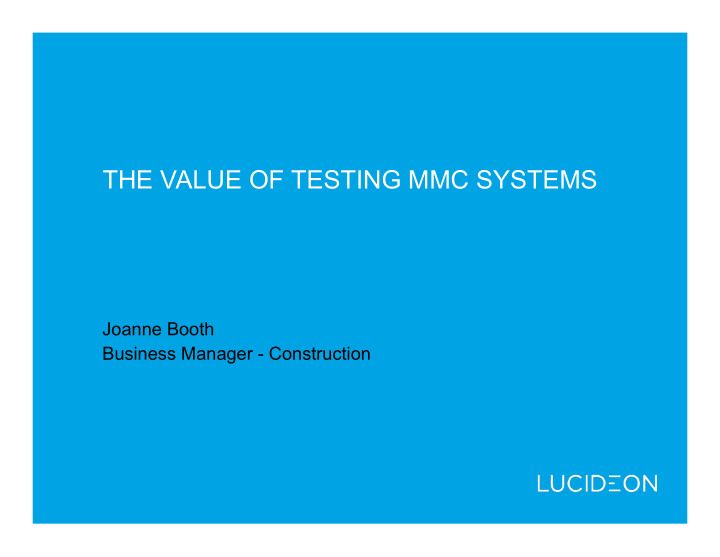



THE VALUE OF TESTING MMC SYSTEMS Joanne Booth Business Manager - Construction
Overview − Value engineering − Structural testing − Component tests − Site testing − Durability assessments − Transportability studies
Value engineering − Value engineering (VE) can be used at various stages throughout the whole process, from the design stage through to materials selection, manufacturing, transportation and build − The biggest savings can be made at the start of the process − VE is not just about reducing materials costs, it includes processes, construction methods, long-term use of the building and transportation − The full savings can easily off-set the costs of the VE process
Value engineering design − Design by Eurocode can lead to using larger material sections − Designed connections − Design for robustness for short periods of use − Redundancy of fixings − Materials selection
Structural testing − Compressive frame loading − Wind loading − Impact testing − Racking loading − Fatigue loading − Floor loading
Structural testing
Structural testing
Component tests − Chimneys − Dormers − Canopies − Panel connections − Balcony connectors − Balustrades − Bathroom pods
Component tests
Site testing − Large-scale racking tests − Water tightness − Rain penetration − Verification of loading points − Impact testing − Acoustic − Thermal assessments
Site testing – Premier Modular − Large-scale assessment of racking resistance of full modules
Site testing – Premier Modular
Durability assessments − Accelerated weathering − Condensation risks − Water tightness − Air tightness − Extended 60-year assessments − Thermal performance
Durability assessments − Testing of the full system must be carried out − It’s not sufficient to only test the individual components − All components need to be CE marked individually − The full system may fall outside of the exact scope of the available standards − The most relevant standard must be chosen − Composite action of the system is important
Hygrothermal test methodology - ETAGs Cycles: − 80 X 6 hour heat-rain cycles − Heat to 70 o C and saturated with water at 13 o C − 5 X 24 hour heat-cold cycles − Heat to 50 o C and freeze to -20 o C − 30 X 6 hour wet-freeze cycles − Heat to 20 o C, soak with water for 8 hours and then freeze to -20 o C
Durability testing – Berkeley Modular − Condensation risk
Durability testing – Berkeley Modular
Transportability studies − Strain gauges on the frame − Accelerometers − Crack monitoring of the cladding − Ultrasonic measurements − Opening up of panel joints
Benchmarking levels − The performance of the panels need to be benchmarked prior to lifting to establish any drop-off in performance due to lifting and transportation, this includes: − Measuring air leakage of panel joints − Thermal imaging to check insulation fill − Visual inspection of fixings − Visual inspection of cladding (particularly at reveals) − Penetration sizes
Transportability – WElink Homes − Live strain readings on the frame taken from lifting onto stillages and on the full journey − Fixed strain readings on the cladding system
Transportability – WElink Homes
Summary Testing of systems ensures that building control, insurers and mortgage providers are satisfied that systems have adequate longevity and meet relevant regulations. This is achieved through: − Structural assessments to ensure compliance with relevant fabrication / building standards − Appropriate physical and environmental testing − Assessment of fixings and ancillary components − Monitoring of transportation, unloading and construction methods
Thank you Contact details T +44 (0)1782 764410 M +44 (0)7805 269886 E joanne.booth@lucideon.com W www.lucideon.com
Recommend
More recommend